Hydrodynamic Modelling and Morphometric Assessment of Supratidal Boulder Transport on the Moroccan Atlantic Coast: A Dual-Site Analysis
Abstract
1. Introduction
2. Materials and Methods
2.1. Study Area Description
2.2. Geomorphometric Boulder Analysis
2.3. Photo-Documentation
2.4. Post-Storm Observations
2.4.1. Measuring Boulder Movement
2.4.2. Flow Velocity Calculation
3. Results
3.1. Boulder Distribution and Morphometry
3.1.1. Oued Cherrat (Site 1)
3.1.2. Mansouria (Site 2)
3.2. Boulder Dynamics
3.2.1. Oued Cherrat
3.2.2. Mansouria
3.3. Estimation of the Minimum Flow Velocity for Initiation of Boulder Motion
3.3.1. Oued Cherrat (Site 1)
3.3.2. Mansouria (Site 2)
4. Discussion
4.1. Boulder Morphometric and Topographic Relationships
4.2. Boulder Transport Dynamics
4.3. Flow Velocity Estimates and Comparison with the Literature
4.4. Origin of the Boulders: Storm or Tsunami?
5. Conclusions
Author Contributions
Funding
Data Availability Statement
Acknowledgments
Conflicts of Interest
References
- Causon Deguara, J.; Gauci, R.; Inkpen, R. Coastal Boulder Deposits in the Mediterranean: A Comprehensive Review of Research and Findings. Mediterr. Geosci. Rev. 2025, 7, 255–274. [Google Scholar] [CrossRef]
- Cox, R.; o’Boyle, L.; Cytrynbaum, J. Imbricated Coastal Boulder Deposits Are Formed by Storm Waves, and Can Preserve a Long-Term Storminess Record. Sci. Rep. 2019, 9, 10784. [Google Scholar] [CrossRef]
- Nott, J. Waves, Coastal Boulder Deposits and the Importance of the Pre-Transport Setting. Earth Planet. Sci. Lett. 2003, 210, 269–276. [Google Scholar] [CrossRef]
- Mhammdi, N.; Medina, F.; Kelletat, D.; Ahmamou, M.; Aloussi, L. Large Boulders along the Rabat Coast (Morocco); Possible Emplacement by the November, 1st, 1755 A.D. Tsunami. Sci. Tsunami Hazards 2008, 27, 17–30. [Google Scholar]
- Kennedy, A.; Cox, R.; Engel, M.; Speyrer, E.; Lau, A.; Mori, N. The Inundation Signatures on Rocky Coastlines Global Database for Coastal Boulder Deposits (ISROC-DB). Mar. Geol. 2025, 487, 107581. [Google Scholar] [CrossRef]
- Nott, J. How High Was the Storm Surge from Tropical Cyclone Mahina?: North Queensland, 1899. Aust. J. Emerg. Manag. 2000, 15, 14–19. [Google Scholar]
- Noormets, R.; Crook, K.; Felton, E. Sedimentology of Rocky Shorelines: 3.: Hydrodynamics of Megaclast Emplacement and Transport on a Shore Platform, Oahu, Hawaii. Sediment. Geol. 2004, 172, 41–65. [Google Scholar] [CrossRef]
- Hall, A.; Hansom, J.; Williams, D.; Jarvis, J. Distribution, Geomorphology and Lithofacies of Cliff-Top Storm Deposits: Examples from the High-Energy Coasts of Scotland and Ireland. Mar. Geol. 2006, 232, 131–155. [Google Scholar] [CrossRef]
- Goto, K.; Miyagi, K.; Kawamata, H.; Imamura, F. Discrimination of Boulders Deposited by Tsunamis and Storm Waves at Ishigaki Island, Japan. Mar. Geol. 2010, 269, 34–45. [Google Scholar] [CrossRef]
- Qiu, H.; Li, T.; Zhang, B. The Impact of Climate Change on the Earth System and Its Simulation Predictions: Progress, Challenges, and Future Directions. Geogr. Res. Bull. 2024, 3, 231–246. [Google Scholar]
- Feng, S.; Hu, C.; Li, X.; Sun, W.; Quaye, J.A.; Su, H.; Dong, C. Tempestites in the Marine Environment: Review and Perspectives. Int. Geol. Rev. 2025, 67, 1353–1375. [Google Scholar] [CrossRef]
- Mhammdi, N.; Medina, F.; Font, E.; Belkhayat, Z.; Geawhari, M.A. Sedimentary evidence of palaeo-tsunami deposits along the Loukkos estuary (Moroccan Atlantic coast). Sci. Tsunami Hazards 2015, 34, 83–100. [Google Scholar]
- El Messaoudi, B.; Ait Laâmel, M.; El Hou, M.; Bouksim, H. Situations Des Fortes Houles Sur Les Côtes Atlantiques Marocaines. In Actes Session Plénière Académie Hassan II des Sciences & Techniques; Académie Hassan II des Sciences et Techniques: Rabat, Morocco, 2016; pp. 79–99. [Google Scholar]
- Cherfaoui, N.; Doghmi, H. Vagues Dans l’océan: Nouveau Regard Sur Les Digues Portuaires; Sciences de l’Ingénieur: Rabat, Morocco, 2002; ISBN 978-9954-8143-0-7. [Google Scholar]
- Cox, R.; Ardhuin, F.; Dias, F.; Autret, R.; Beisiegel, N.; Earlie, C.; Herterich, J.; Kennedy, A.; Paris, R.; Raby, A.; et al. Systematic Review Shows That Work Done by Storm Waves Can Be Misinterpreted as Tsunami-Related Because Commonly Used Hydrodynamic Equations Are Flawed. Front. Mar. Sci. 2020, 7, 4. [Google Scholar] [CrossRef]
- Cox, R.; Lopes, W.A.; Jahn, K.L. Quantitative Roundness Analysis of Coastal Boulder Deposits. Mar. Geol. 2018, 396, 114–141. [Google Scholar] [CrossRef]
- Cox, R.; Zentner, D.B.; Kirchner, B.J.; Cook, M.S. Boulder Ridges on the Aran Islands (Ireland): Recent Movements Caused by Storm Waves, Not Tsunamis. J. Geol. 2012, 120, 249–272. [Google Scholar] [CrossRef]
- Nandasena, N.A.K.; Paris, R.; Tanaka, N. Reassessment of Hydrodynamic Equations: Minimum Flow Velocity to Initiate Boulder Transport by High Energy Events (Storms, Tsunamis). Mar. Geol. 2011, 281, 70–84. [Google Scholar] [CrossRef]
- Nandasena, N.A.K.; Scicchitano, G.; Scardino, G.; Milella, M.; Piscitelli, A.; Mastronuzzi, G. Boulder Displacements along Rocky Coasts: A New Deterministic and Theoretical Approach to Improve Incipient Motion Formulas. Geomorphology 2022, 407, 108217. [Google Scholar] [CrossRef]
- Medina, F.; Mhammdi, N.; Chiguer, A.; Akil, M.; Jaaidi, E. The Rabat and Larache Boulder Fields; New Examples of High-Energy Deposits Related to Storms and Tsunami Waves in North-Western Morocco. Nat. Hazards 2011, 59, 725–747. [Google Scholar] [CrossRef]
- Khalfaoui, O.; Joudar, I.; Chahid, N.E.; Khalidi, K.E.; Minoubi, A.; Bouchkara, M.; Zourarah, B. The Safi Boulders (Morocco): Evidence of Past Extreme Wave Events. Mar. Geol. 2024, 470, 107265. [Google Scholar] [CrossRef]
- Cox, R.; Bourke, M.C.; Engel, M.; Kennedy, A.B.; Lau, A.; Suanez, S.; Boulton, S.J.; Oliveira, M.A.; Paris, R.; Salmanidou, D.; et al. Understanding Extreme-Wave Hazards on High-Energy Coasts Requires a Standardised Approach to Field Data Collection: Analysis and Recommendations. EGUsphere 2025, 2025, 1–38. [Google Scholar] [CrossRef]
- Nandasena, N.A.K.; Tanaka, N.; Sasaki, Y.; Osada, M. Boulder Transport by the 2011 Great East Japan Tsunami: Comprehensive Field Observations and Whither Model Predictions? Mar. Geol. 2013, 346, 292–309, reprinted in Mar. Geol. Mar. Geol. 2014, 358, 49–66. [Google Scholar] [CrossRef]
- Schneider, M.; Bernardino, M.; Gonçalves, M.; Guedes Soares, C. Wave Energy Assessment for the Atlantic Coast of Morocco. J. Mar. Sci. Eng. 2023, 11, 2159. [Google Scholar] [CrossRef]
- Mhammdi, N.; Medina, F.; Belkhayat, Z.; Aoula, R.E.; Geawahri, M.-A.; Chiguer, A. Marine Storms along the Moroccan Atlantic Coast: An Underrated Natural Hazard? J. Afr. Earth Sci. 2020, 163, 103730. [Google Scholar] [CrossRef]
- Farhaoui, I.; Dakki, M.; Saloui, A. Morphodynamic Classification of Morocco’s Steep Coasts Using Multivariate Methods and Remote Data. J. Coast. Res. 2025, 41, 431–451. [Google Scholar] [CrossRef]
- Gharnate, A.; Taouali, O.; Mhammdi, N. Shoreline Change Assessment of the Moroccan Atlantic Coastline Using DSAS Techniques. J. Coast. Res. 2024, 40, 418–435. [Google Scholar] [CrossRef]
- Beaudet, G.; Maurer, G.; Ruellan, A. Le Quaternaire Marocain. Observations et Hypothèses Nouvelles. Rev. Géographie Phys. Géologie Dyn. 1967, 9, 269–310. [Google Scholar]
- Rouch, J. Le Maroc Maritime Français. In Mémoires de la Société des Sciences Naturelles du Maroc; Larose, C.E., Ed.; Au Siège de L’institut Scientifique Chérifien: Paris, France; Rabat, Morocco, 1931. [Google Scholar]
- Engel, M.; May, S.M. Bonaire’s Boulder Fields Revisited: Evidence for Holocene Tsunami Impact on the Leeward Antilles. Quat. Sci. Rev. 2012, 54, 126–141. [Google Scholar] [CrossRef]
- Lario, J.; Zazo, C.; Goy, J.L. Tectonic and Morphosedimentary Features of the 2010 Chile Earthquake and Tsunami in the Arauco Gulf and Mataquito River (Central Chile). Geomorphology 2016, 267, 16–24. [Google Scholar] [CrossRef]
- Lario, J.; Spencer, C.; Azcárate, T.; Marchante, A.; Garduño Monroy, V.; Macías, J.; Ortega, S. An Extreme Wave Event in Eastern Yucatán, Mexico: Evidence of a Paleotsunami Event during the Mayan Times. Sedimentology 2020, 67, 1481–1504. [Google Scholar] [CrossRef]
- Sanad, H.; Moussadek, R.; Mouhir, L.; Lhaj, M.O.; Dakak, H.; Manhou, K.; Zouahri, A. Monte Carlo Simulation for Evaluating Spatial Dynamics of Toxic Metals and Potential Health Hazards in Sebou Basin Surface Water. Sci. Rep. 2025, 15, 29471. [Google Scholar] [CrossRef]
- Sanad, H.; Moussadek, R.; Mouhir, L.; Lhaj, M.O.; Dakak, H.; Zouahri, A. Geospatial Analysis of Trace Metal Pollution and Ecological Risks in River Sediments from Agrochemical Sources in Morocco’s Sebou Basin. Sci. Rep. 2025, 15, 16701. [Google Scholar] [CrossRef] [PubMed]
- Sanad, H.; Moussadek, R.; Mouhir, L.; Lhaj, M.O.; Zahidi, K.; Dakak, H.; Manhou, K.; Zouahri, A. Ecological and Human Health Hazards Evaluation of Toxic Metal Contamination in Agricultural Lands Using Multi-Index and Geostatistical Techniques across the Mnasra Area of Morocco’s Gharb Plain Region. J. Hazard. Mater. Adv. 2025, 18, 100724. [Google Scholar] [CrossRef]
- Manhou, K.; Taghouti, M.; Moussadek, R.; Elyacoubi, H.; Bennani, S.; Zouahri, A.; Ghanimi, A.; Sanad, H.; Oueld Lhaj, M.; Hmouni, D.; et al. Performance, Agro-Morphological, and Quality Traits of Durum Wheat (Triticum Turgidum L. Ssp. Durum Desf.) Germplasm: A Case Study in Jemâa Shaïm, Morocco. Plants 2025, 14, 1508. [Google Scholar] [CrossRef]
- Oueld Lhaj, M.; Moussadek, R.; Mouhir, L.; Sanad, H.; Manhou, K.; Iben Halima, O.; Yachou, H.; Zouahri, A.; Mdarhri Alaoui, M. Application of Compost as an Organic Amendment for Enhancing Soil Quality and Sweet Basil (Ocimum Basilicum L.) Growth: Agronomic and Ecotoxicological Evaluation. Agronomy 2025, 15, 1045. [Google Scholar] [CrossRef]
- Etienne, S.; Paris, R. Boulder Accumulations Related to Storms on the South Coast of the Reykjanes Peninsula (Iceland). Geomorphology 2010, 114, 55–70. [Google Scholar] [CrossRef]
- Barbano, M.; Pirrotta, C.; Gerardi, F. Large Boulders along the South-Eastern Ionian Coast of Sicily: Storm or Tsunami Deposits? Mar. Geol. 2010, 275, 140–154. [Google Scholar] [CrossRef]
- Kennedy, A.B.; Mori, N.; Zhang, Y.; Yasuda, T.; Chen, S.-E.; Tajima, Y.; Pecor, W.; Toride, K. Observations and Modeling of Coastal Boulder Transport and Loading During Super Typhoon Haiyan. Coast. Eng. J. 2016, 58, 1640004. [Google Scholar] [CrossRef]
- Nandasena, N.A.K. Chapter 29—Perspective of Incipient Motion Formulas: Boulder Transport by High-Energy Waves. In Geological Records of Tsunamis and Other Extreme Waves; Engel, M., Pilarczyk, J., May, S.M., Brill, D., Garrett, E., Eds.; Elsevier: Amsterdam, The Netherlands, 2020; pp. 641–659. ISBN 978-0-12-815686-5. [Google Scholar]
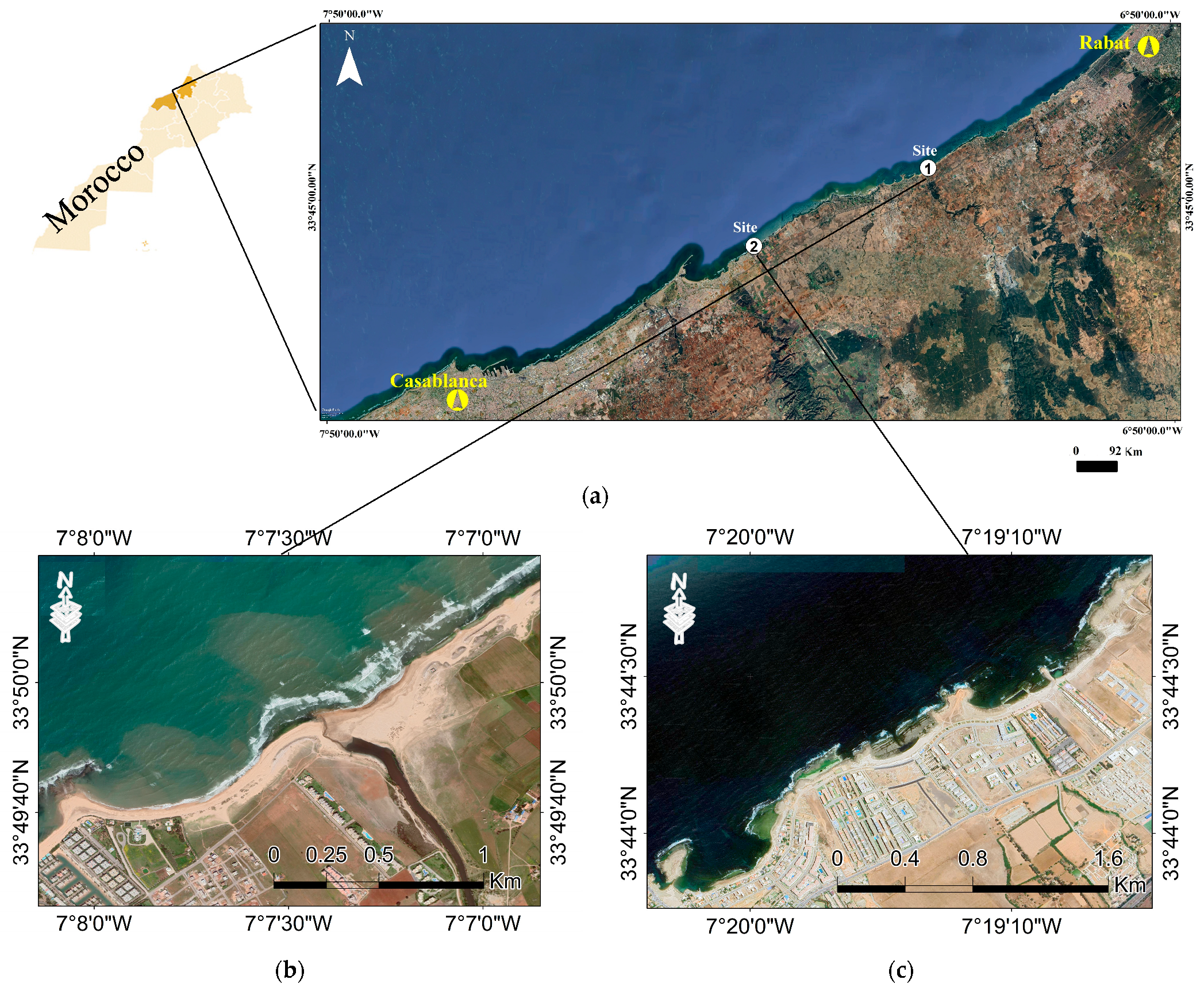
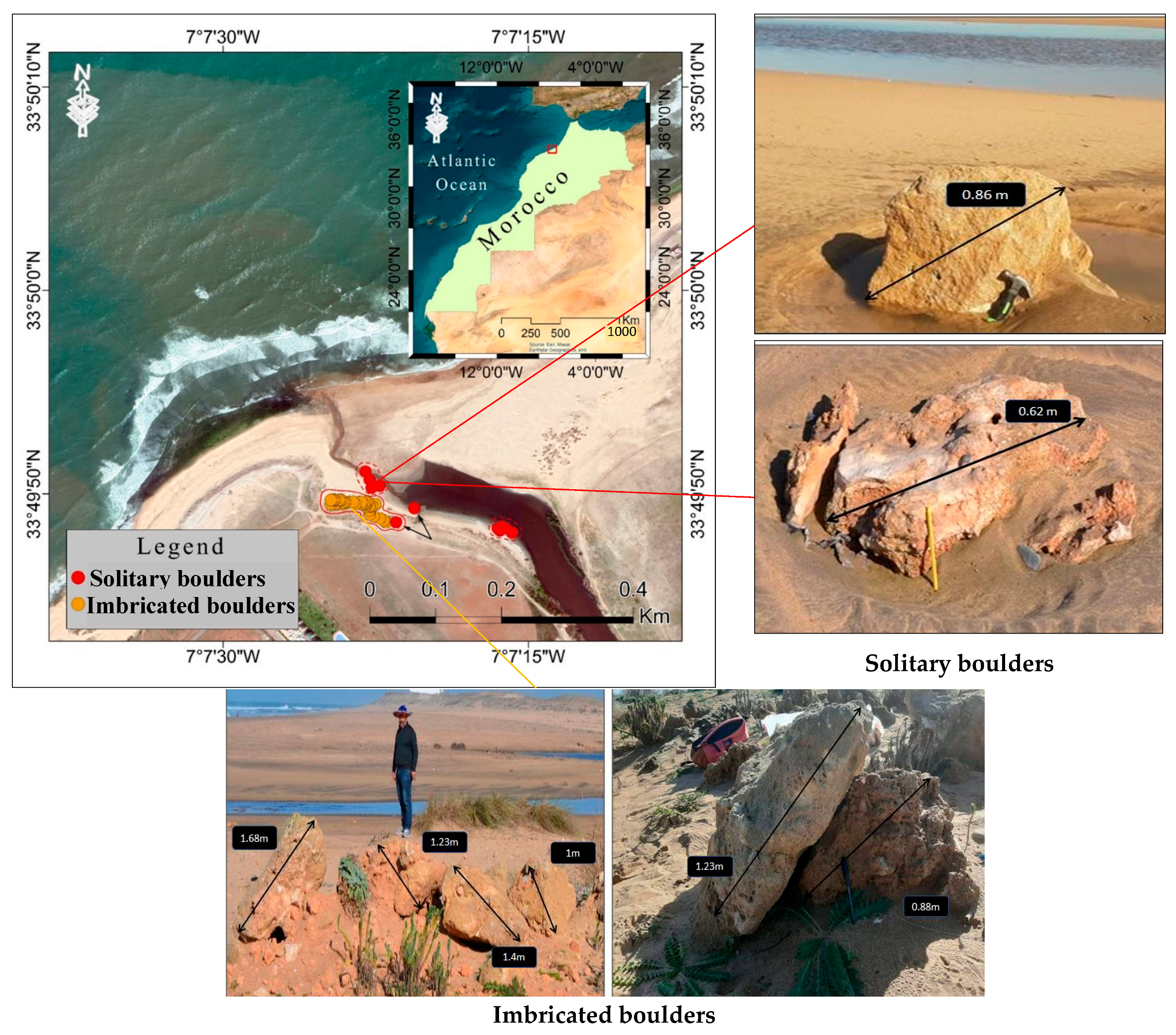

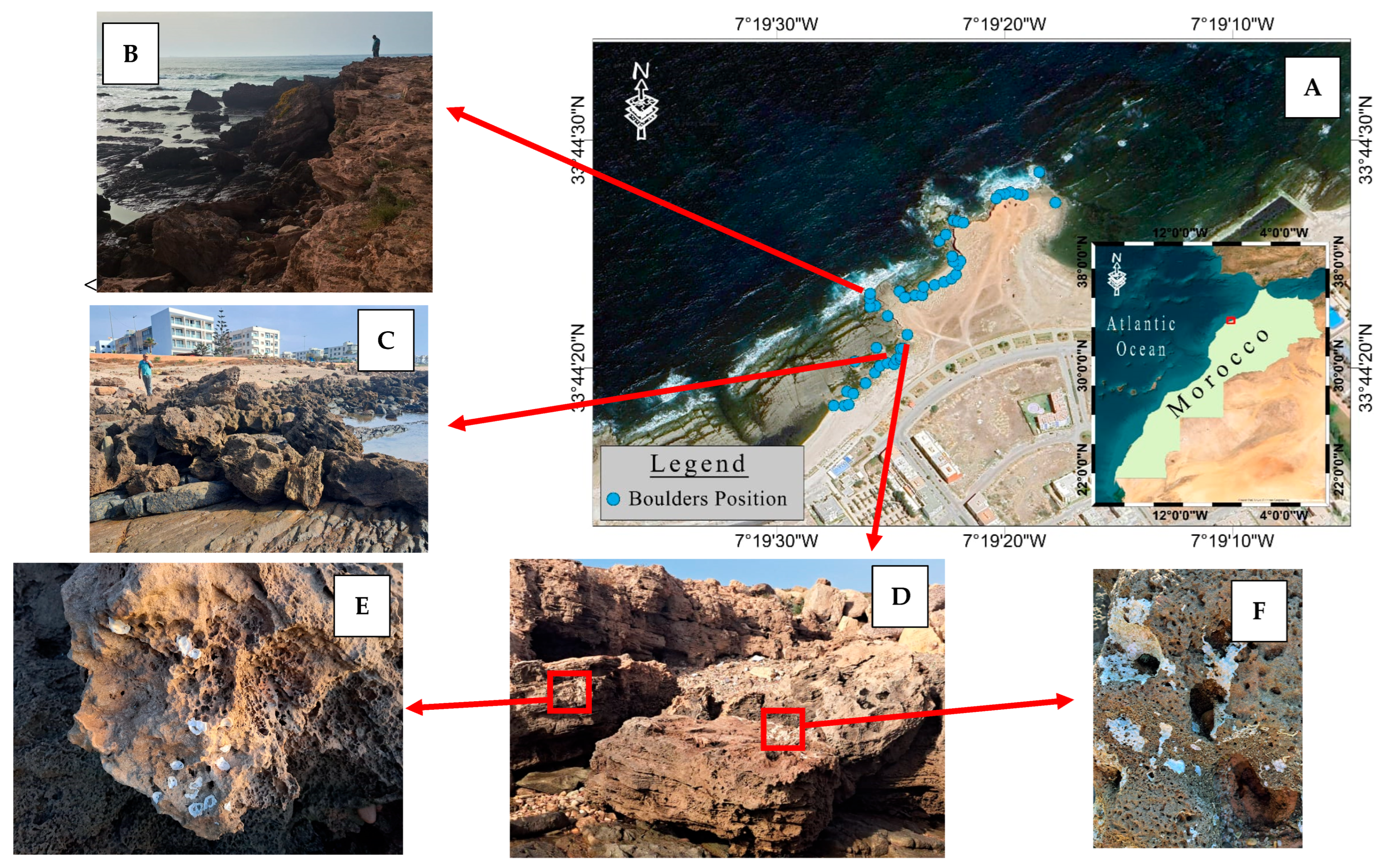


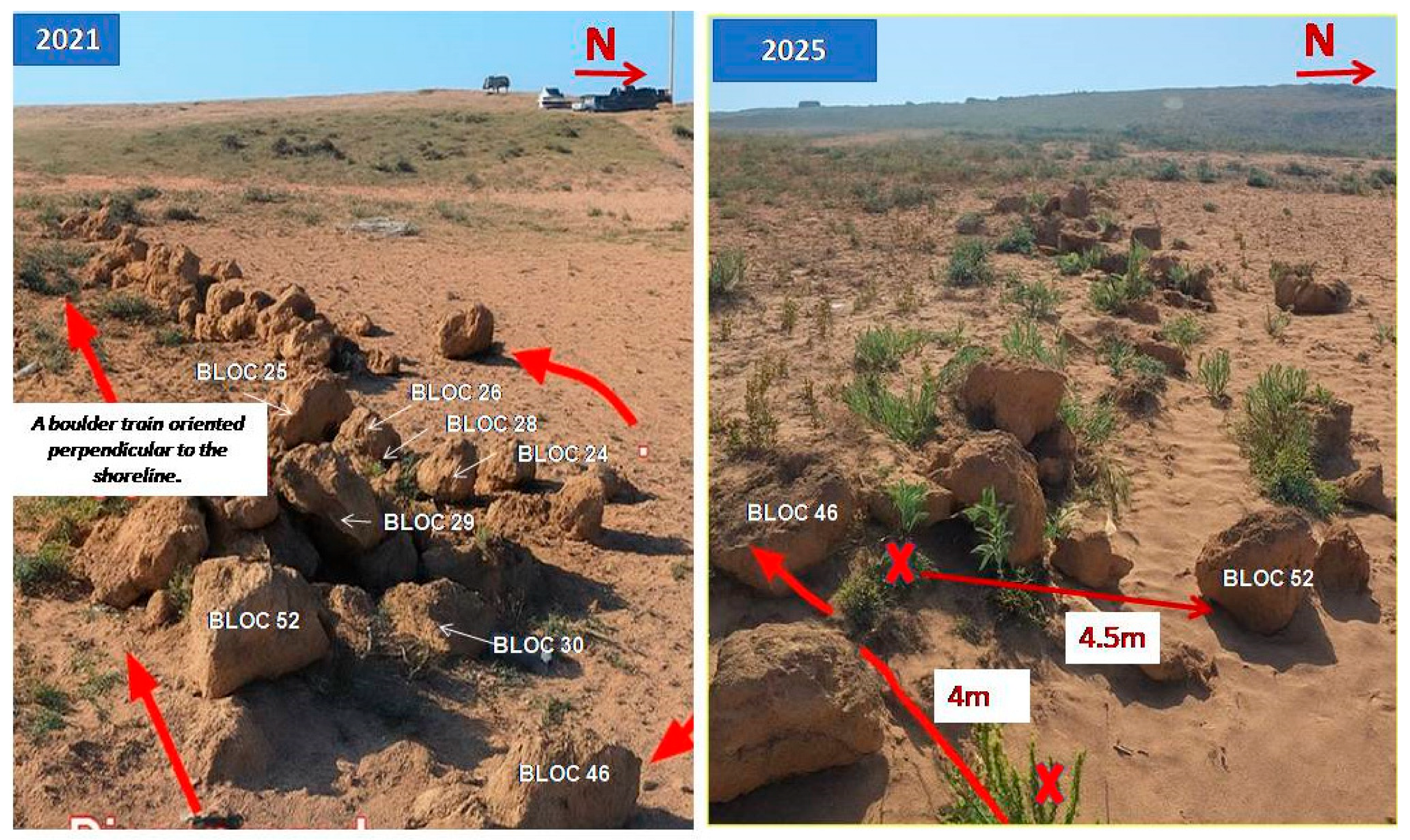
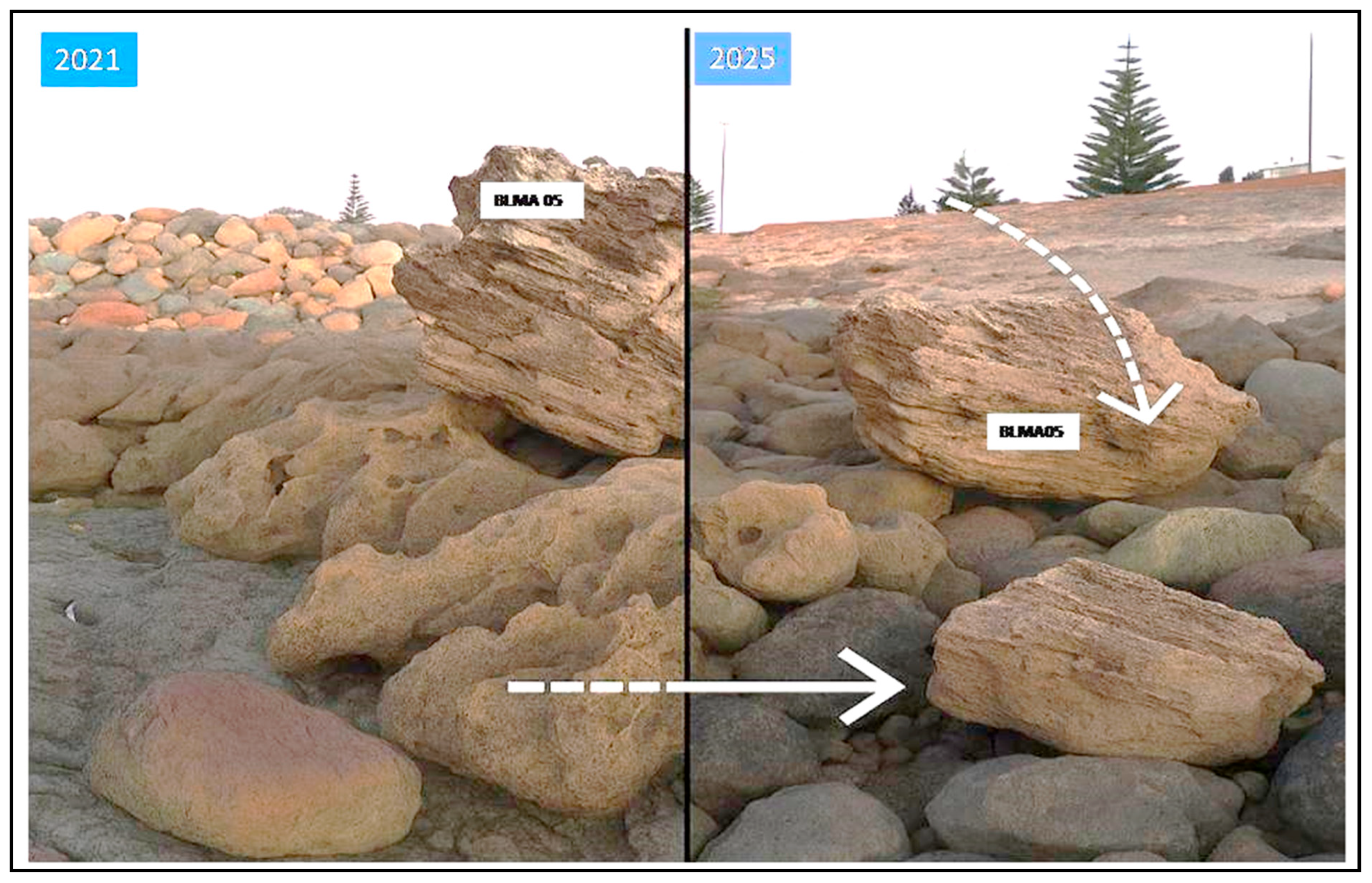
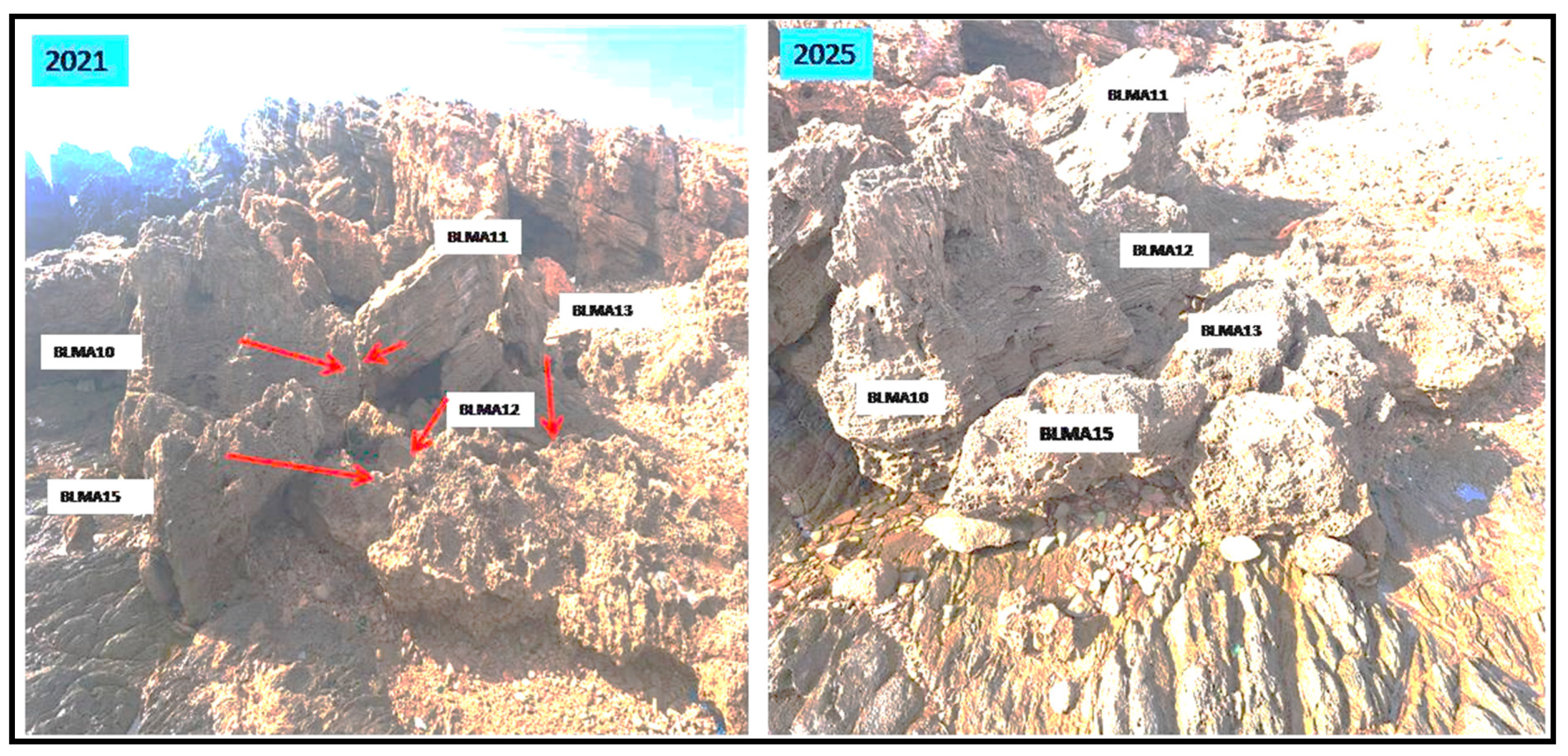
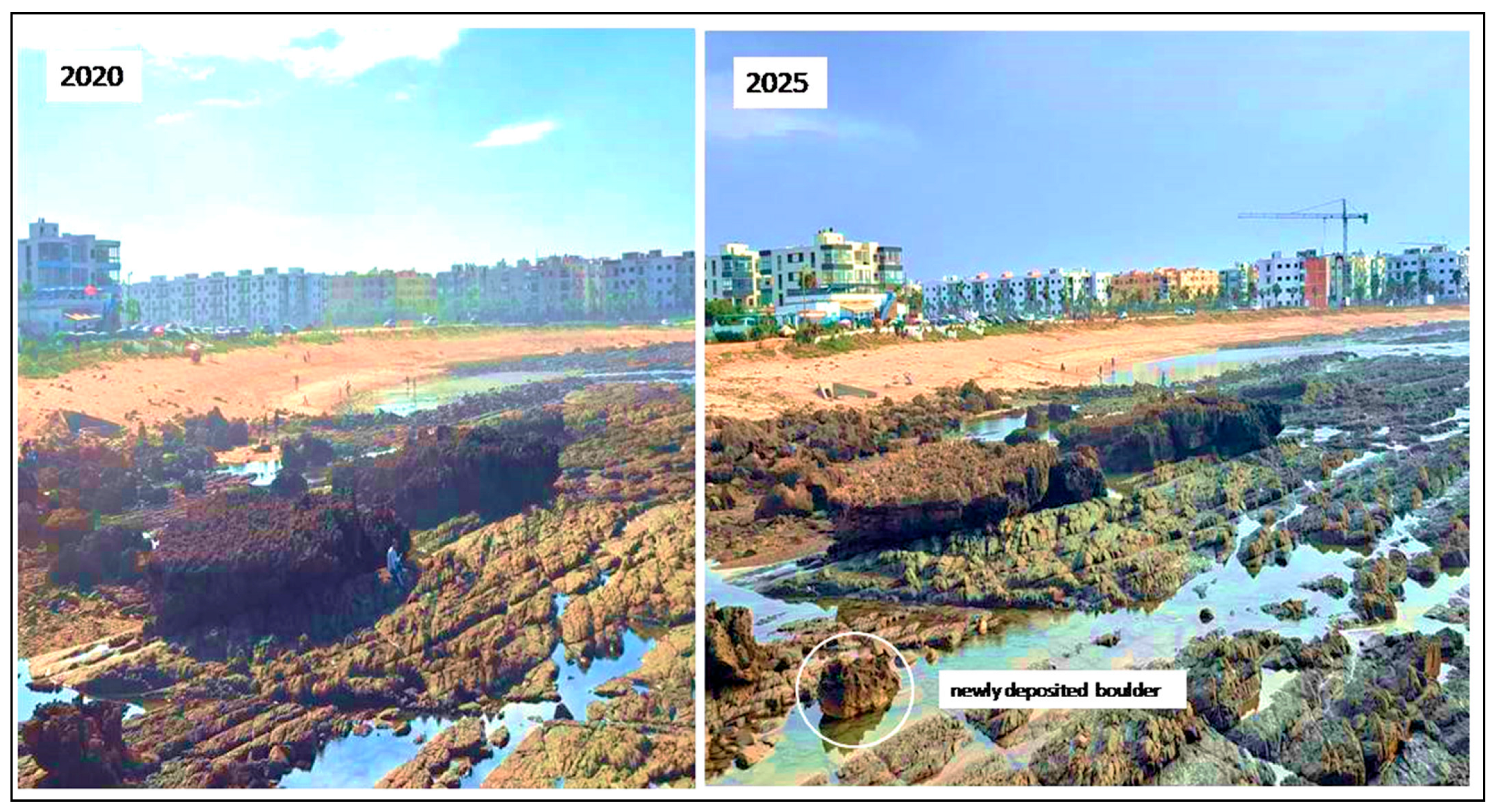

| Boulders | A-Axis | B-Axis | C-Axis | Longitude (X) | Latitude (Y) | D (m) | H (m) | CV (m3) | Density (t/m3) | Mass (t) | Slope Angle (Radians) | |
|---|---|---|---|---|---|---|---|---|---|---|---|---|
| Solitary boulders | BLOC01 | 0.55 | 0.15 | 0.45 | 33°49′50.7″ N | 7°07′22.8″ W | 63.5 | 2.1 | 0.02 | 2.2 | 0.05 | 0.03 |
| BLOC02 | 0.65 | 0.59 | 0.15 | 33°49′51.1″ N | 7°07′23.0″ W | 65.43 | 2.3 | 0.03 | 2.2 | 0.08 | 0.04 | |
| BLOC03 | 1.1 | 0.9 | 0.34 | 33°49′50.3″ N | 7°07′22.7″ W | 60.56 | 2.2 | 0.20 | 2.2 | 0.44 | 0.04 | |
| BLOC04 | 0.62 | 0.6 | 0.18 | 33°49′50.4″ N | 7°07′22.3″ W | 51.87 | 2.2 | 0.04 | 2.2 | 0.09 | 0.04 | |
| BLOC05 | 0.7 | 0.4 | 0.48 | 33°49′49.3″ N | 7°07′20.6″ W | 48.78 | 1.9 | 0.08 | 2.2 | 0.18 | 0.04 | |
| BLOC06 | 0.86 | 0.26 | 0.4 | 33°49′48.2″ N | 7°07′16.4″ W | 30.12 | 1.2 | 0.05 | 2.2 | 0.12 | 0.04 | |
| BLOC09 | 0.7 | 0.64 | 0.4 | 33°49′48.3″ N | 7°07′16.5″ W | 33.89 | 1.2 | 0.11 | 2.2 | 0.24 | 0.04 | |
| BLOC10 | 0.7 | 0.4 | 0.28 | 33°49′48.4″ N | 7°07′16.3″ W | 37.56 | 1.3 | 0.05 | 2.2 | 0.10 | 0.03 | |
| BLOC11 | 0.63 | 0.38 | 0.2 | 33°49′48.3″ N | 7°07′16.1″ W | 66.98 | 2.7 | 0.03 | 2.2 | 0.06 | 0.04 | |
| BLOC12 | 0.25 | 0.18 | 0.13 | 33°49′48.1″ N | 7°07′15.8″ W | 62.11 | 2.5 | 0.01 | 2.2 | 0.01 | 0.04 | |
| BLOC13 | 0.6 | 0.4 | 0.2 | 33°49′48.6″ N | 7°07′21.5″ W | 61.17 | 2.6 | 0.03 | 2.2 | 0.06 | 0.04 | |
| BLOC14 | 0.5 | 0.5 | 0.2 | 33°49′48.6″ N | 7°07′21.5″ W | 45.23 | 1.8 | 0.03 | 2.2 | 0.07 | 0.04 | |
| BLOC15 | 0.7 | 0.35 | 0.4 | 33°49′48.6″ N | 7°07′21.5″ W | 84.36 | 2.8 | 0.06 | 2.2 | 0.13 | 0.03 | |
| BLOC16 | 0.7 | 0.4 | 0.4 | 33°49′48.6″ N | 7°07′21.5″ W | 85.39 | 2.9 | 0.07 | 2.2 | 0.15 | 0.03 | |
| BLOC17 | 0.5 | 0.5 | 0.5 | 33°49′48.6″ N | 7°07′21.5″ W | 76.38 | 2.6 | 0.08 | 2.2 | 0.17 | 0.03 | |
| BLOC18 | 0.5 | 0.2 | 0.3 | 33°49′48.6″ N | 7°07′21.5″ W | 87.64 | 2.8 | 0.02 | 2.2 | 0.04 | 0.03 | |
| BLOC19 | 0.5 | 0.3 | 0.2 | 33°49′48.6″ N | 7°07′21.5″ W | 93.67 | 3.1 | 0.02 | 2.2 | 0.04 | 0.03 | |
| BLOC20 | 0.65 | 0.25 | 0.3 | 33°49′48.6″ N | 7°07′21.5″ W | 89.08 | 2.9 | 0.03 | 2.2 | 0.06 | 0.03 | |
| BLOC21 | 0.66 | 0.65 | 0.46 | 33°49′48.6″ N | 7°07′21.5″ W | 67.32 | 2.3 | 0.12 | 2.2 | 0.26 | 0.03 | |
| BLOC22 | 0.85 | 0.53 | 0.25 | 33°49′48.6″ N | 7°07′21.5″ W | 77.18 | 2.7 | 0.07 | 2.2 | 0.15 | 0.03 | |
| Imbricated boulders | BLOC23 | 2.25 | 1.2 | 0.5 | 33°49′48.6″ N | 7°07′21.5″ W | 101.1 | 2.5 | 0.81 | 2.2 | 1.78 | 0.02 |
| BLOC24 | 1.68 | 0.66 | 0.45 | 33°49′48.6″ N | 7°07′22.0″ W | 101.3 | 2.3 | 0.30 | 2.2 | 0.66 | 0.02 | |
| BLOC25 | 1 | 0.53 | 0.23 | 33°49′48.7″ N | 7°07′22.1″ W | 104.5 | 2.4 | 0.07 | 2.2 | 0.16 | 0.02 | |
| BLOC26 | 0.88 | 0.54 | 0.47 | 33°49′48.8″ N | 7°07′22.3″ W | 106 | 2.4 | 0.13 | 2.2 | 0.29 | 0.02 | |
| BLOC27 | 1.4 | 0.83 | 0.73 | 33°49′48.9″ N | 7°07′22.6″ W | 110.4 | 2.2 | 0.51 | 2.2 | 1.12 | 0.02 | |
| BLOC28 | 0.55 | 0.54 | 0.48 | 33°49′49.0″ N | 7°07′22.8″ W | 111.5 | 2.5 | 0.09 | 2.2 | 0.19 | 0.02 | |
| BLOC29 | 1 | 1 | 0.5 | 33°49′49.2″ N | 7°07′22.8″ W | 118 | 2.5 | 0.30 | 2.2 | 0.66 | 0.02 | |
| BLOC30 | 0.59 | 0.44 | 0.51 | 33°49′49.5″ N | 7°07′22.6″ W | 116.3 | 2.5 | 0.08 | 2.2 | 0.17 | 0.02 | |
| BLOC31 | 0.9 | 0.8 | 0.71 | 33°49′49.5″ N | 7°07′22.5″ W | 119.8 | 2.4 | 0.31 | 2.2 | 0.67 | 0.02 | |
| BLOC32 | 0.78 | 0.44 | 0.36 | 33°49′49.4″ N | 7°07′22.7″ W | 124 | 2.4 | 0.07 | 2.2 | 0.16 | 0.02 | |
| BLOC33 | 1.23 | 1 | 0.9 | 33°49′49.4″ N | 7°07′22.8″ W | 122.5 | 2.5 | 0.66 | 2.2 | 1.46 | 0.02 | |
| BLOC34 | 2.5 | 1.5 | 0.98 | 33°49′49.6″ N | 7°07′22.9″ W | 125 | 2.5 | 2.21 | 2.2 | 4.85 | 0.02 | |
| BLOC35 | 2 | 1 | 0.76 | 33°49′49.4″ N | 7°07′23.0″ W | 128 | 2.5 | 0.91 | 2.2 | 2.01 | 0.02 | |
| BLOC36 | 2.2 | 2 | 0.5 | 33°49′49.5″ N | 7°07′23.0″ W | 132 | 2.5 | 1.32 | 2.2 | 2.90 | 0.02 | |
| BLOC37 | 2.3 | 2 | 1.2 | 33°49′49.5″ N | 7°07′23.0″ W | 137 | 2.4 | 3.31 | 2.2 | 7.29 | 0.02 | |
| BLOC38 | 2 | 1.98 | 1.5 | 33°49′49.6″ N | 7°07′23.0″ W | 116 | 2.3 | 3.56 | 2.2 | 7.84 | 0.02 | |
| BLOC39 | 2 | 2 | 1 | 33°49′49.5″ N | 7°07′23.1″ W | 126 | 2.5 | 2.40 | 2.2 | 5.28 | 0.02 | |
| BLOC40 | 2 | 1.5 | 1 | 33°49′49.5″ N | 7°07′23.2″ W | 136.2 | 2.4 | 1.80 | 2.2 | 3.96 | 0.02 | |
| BLOC41 | 1.5 | 1.5 | 0.5 | 33°49′49.6″ N | 7°07′23.3″ W | 135 | 2.5 | 0.68 | 2.2 | 1.49 | 0.02 | |
| BLOC42 | 2 | 1 | 1 | 33°49′49.6″ N | 7°07′23.2″ W | 132 | 2.5 | 1.20 | 2.2 | 2.64 | 0.02 | |
| BLOC43 | 1.5 | 1.2 | 1 | 33°49′49.5″ N | 7°07′23.5″ W | 133 | 2.4 | 1.08 | 2.2 | 2.38 | 0.02 | |
| BLOC44 | 1.5 | 1 | 0.6 | 33°49′49.6″ N | 7°07′23.8″ W | 136.5 | 2.5 | 0.54 | 2.2 | 1.19 | 0.02 | |
| BLOC45 | 2 | 1.5 | 0.5 | 33°49′49.6″ N | 7°07′23.6″ W | 138 | 2.4 | 0.90 | 2.2 | 1.98 | 0.02 | |
| BLOC46 | 2 | 2 | 1.2 | 33°49′49.6″ N | 7°07′23.6″ W | 139.4 | 2.5 | 2.88 | 2.2 | 6.34 | 0.02 | |
| BLOC47 | 2 | 1.5 | 1 | 33°49′49.5″ N | 7°07′24.1″ W | 144 | 2.4 | 1.80 | 2.2 | 3.96 | 0.02 | |
| BLOC48 | 2 | 2 | 1 | 33°49′49.5″ N | 7°07′24.4″ W | 148 | 2.5 | 2.40 | 2.2 | 5.28 | 0.02 | |
| BLOC49 | 1.5 | 1.3 | 1 | 33°49′49.5″ N | 7°07′24.5″ W | 146 | 2.4 | 1.17 | 2.2 | 2.57 | 0.02 | |
| BLOC50 | 1.5 | 1.1 | 1 | 33°49′49.5″ N | 7°07′24.7″ W | 148.3 | 2.2 | 0.99 | 2.2 | 2.18 | 0.01 | |
| BLOC51 | 1.6 | 1 | 0.7 | 33°49′49.6″ N | 7°07′24.0″ W | 144 | 2.2 | 0.67 | 2.2 | 1.48 | 0,02 | |
| BLOC52 | 2 | 2.2 | 1.1 | 33°49′49.6″ N | 7°07′24.1″ W | 147 | 2.3 | 2.90 | 2.2 | 6.39 | 0.02 | |
| BLOC53 | 1.76 | 1.53 | 0.8 | 33°49′49.7″ N | 7°07′24.2″ W | 145 | 2.1 | 1.29 | 2.2 | 2.84 | 0.01 | |
| BLOC54 | 0.98 | 0.67 | 0.7 | 33°49′49.7″ N | 7°07′24.3″ W | 147 | 2.5 | 0.28 | 2.2 | 0.61 | 0.02 | |
| BLOC55 | 1.2 | 1 | 0.9 | 33°49′49.7″ N | 7°07′24.5″ W | 147.9 | 2.25 | 0.65 | 2.2 | 1.43 | 0.02 | |
| BLOC56 | 2 | 1 | 0.5 | 33°49′49.7″ N | 7°07′24.6″ W | 149 | 2.3 | 0.60 | 2.2 | 1.32 | 0.02 | |
| BLOC57 | 1.9 | 1.3 | 1 | 33°49′49.7″ N | 7°07′24.7″ W | 150.5 | 2.1 | 1.48 | 2.2 | 3.26 | 0.01 | |
| Boulders ID | A-Axis | B-Axis | C-Axis | Longitude (X) | Latitude (Y) | D (m) | H (m) | CV (m3) | Density (t/m3) | Mass (t) | Slope Angle (Radians) |
|---|---|---|---|---|---|---|---|---|---|---|---|
| BLMA 01 | 22.00 | 20.00 | 3.50 | 33°44′20.9″ N | 7°19′25.6″ W | 67.63 | 1.5 | 924.00 | 2.2 | 2032.80 | 0.02 |
| BLMA 02 | 20 | 16 | 3.5 | 33°44′20.3″ N | 7°19′26.6″ W | 68.12 | 1.6 | 672.00 | 2.2 | 1478.40 | 0.02 |
| BLMA 03 | 6 | 4.2 | 1.5 | 33°44′18.3″ N | 7°19′27.5″ W | 133.23 | 1.5 | 22.68 | 2.2 | 49.90 | 0.02 |
| BLMA 04 | 10.7 | 8.9 | 2 | 33°44′19.0″ N | 7°19′26.9″ W | 136.37 | 1.2 | 114.28 | 2.2 | 251.41 | 0.02 |
| BLMA 05 | 2 | 1.7 | 1 | 33°44′18.3″ N | 7°19′27.0″ W | 127.09 | 1 | 2.04 | 2.2 | 4.49 | 0.02 |
| BLMA 06 | 1.38 | 1 | 0.5 | 33°44′18.4″ N | 7°19′26.8″ W | 112.11 | 1 | 0.41 | 2.2 | 0.91 | 0.02 |
| BLMA 07 | 2.72 | 3.36 | 1.3 | 33°44′18.9″ N | 7°19′26.6″ W | 114.22 | 1 | 7.13 | 2.2 | 15.68 | 0.02 |
| BLMA 08 | 4.65 | 4.31 | 2 | 33°44′19.3″ N | 7°19′26.1″ W | 116.14 | 1 | 24.05 | 2.2 | 52.91 | 0.02 |
| BLMA 09 | 6.76 | 5.23 | 2.3 | 33°44′19.8″ N | 7°19′25.7″ W | 118.67 | 1 | 48.79 | 2.2 | 107.34 | 0.02 |
| BLMA 10 | 3.93 | 2.95 | 1.4 | 33°44′20.1″ N | 7°19′25.5″ W | 86.89 | 1 | 9.74 | 2.2 | 21.42 | 0.02 |
| BLMA 11 | 3.63 | 2.12 | 1.12 | 33°44′20.2″ N | 7°19′25.1″ W | 92.46 | 1 | 5.17 | 2.2 | 11.38 | 0.02 |
| BLMA 12 | 3.42 | 1.13 | 1 | 33°44′20.2″ N | 7°19′24.8″ W | 93.35 | 3 | 2.32 | 2.2 | 5.10 | 0.02 |
| BLMA 13 | 2.65 | 2 | 1.14 | 33°44′20.4″ N | 7°19′24.7″ W | 91.6 | 3 | 3.63 | 2.2 | 7.98 | 0.03 |
| BLMA 14 | 2.86 | 2.3 | 1.15 | 33°44′20.4″ N | 7°19′24.6″ W | 90 | 3 | 4.54 | 2.2 | 9.99 | 0.03 |
| BLMA 15 | 2.6 | 2 | 1 | 33°44′20.5″ N | 7°19′24.5″ W | 93.76 | 3 | 3.12 | 2.2 | 6.86 | 0.03 |
| BLMA 16 | 3.5 | 2.3 | 2 | 33°44′20.8″ N | 7°19′24.6″ W | 99.47 | 3 | 9.66 | 2.2 | 21.25 | 0.03 |
| BLMA 17 | 3.2 | 2.4 | 2.1 | 33°44′20.9″ N | 7°19′24.4″ W | 98.39 | 3 | 9.68 | 2.2 | 21.29 | 0.03 |
| BLMA 18 | 4.2 | 2.11 | 2 | 33°44′21.5″ N | 7°19′24.3″ W | 93.48 | 2 | 10.63 | 2.2 | 23.40 | 0.02 |
| BLMA 19 | 5.28 | 2.3 | 2.14 | 33°44′22.3″ N | 7°19′25.1″ W | 77.8 | 1.1 | 15.59 | 2.2 | 34.30 | 0.01 |
| BLMA 20 | 6.63 | 4.73 | 2.3 | 33°44′22.7″ N | 7°19′25.7″ W | 81.76 | 1.2 | 43.28 | 2.2 | 95.21 | 0.01 |
| BLMA 21 | 8.31 | 8.03 | 3.5 | 33°44′22.7″ N | 7°19′25.9″ W | 71.8 | 1 | 140.13 | 2.2 | 308.29 | 0.01 |
| BLMA 22 | 5.54 | 5.14 | 2.6 | 33°44′23.1″ N | 7°19′25.9″ W | 70.5 | 1 | 44.42 | 2.2 | 97.73 | 0.01 |
| BLMA 23 | 6.42 | 5.62 | 2.5 | 33°44′23.3″ N | 7°19′25.9″ W | 70.2 | 1.5 | 54.12 | 2.2 | 119.07 | 0.02 |
| BLMA 24 | 7.2 | 4.5 | 2 | 33°44′23.4″ N | 7°19′24.6″ W | 68 | 1 | 38.88 | 2.2 | 85.54 | 0.01 |
| BLMA 25 | 8.3 | 3.6 | 1.2 | 33°44′23.1″ N | 7°19′24.3″ W | 69 | 1 | 21.51 | 2.2 | 47.33 | 0.01 |
| BLMA 26 | 4.6 | 4.9 | 1.9 | 33°44′23.1″ N | 7°19′24.4″ W | 67.5 | 1 | 25.70 | 2.2 | 56.53 | 0.01 |
| BLMA 27 | 5.4 | 3 | 1 | 33°44′23.2″ N | 7°19′23.9″ W | 66 | 1.3 | 9.72 | 2.2 | 21.38 | 0.02 |
| BLMA 28 | 7 | 4 | 2.3 | 33°44′23.2″ N | 7°19′23.6″ W | 65 | 1.2 | 38.64 | 2.2 | 85.01 | 0.02 |
| BLMA 29 | 6.25 | 3 | 2.5 | 33°44′23.6″ N | 7°19′23.6″ W | 64.6 | 1 | 28.13 | 2.2 | 61.88 | 0.02 |
| BLMA 30 | 2.13 | 1.5 | 1 | 33°44′23.6″ N | 7°19′23.1″ W | 63 | 2.2 | 1.92 | 2.2 | 4.22 | 0.03 |
| BLMA 31 | 6 | 3.5 | 2 | 33°44′23.8″ N | 7°19′22.7″ W | 55 | 2.1 | 25.20 | 2.2 | 55.44 | 0.04 |
| BLMA 32 | 5 | 3.4 | 1 | 33°44′23.9″ N | 7°19′22.3″ W | 45 | 2 | 10.20 | 2.2 | 22.44 | 0.04 |
| BLMA 33 | 5.5 | 4.3 | 2.6 | 33°44′24.1″ N | 7°19′22.1″ W | 35.68 | 2 | 36.89 | 2.2 | 81.17 | 0.06 |
| BLMA 34 | 6.4 | 6 | 3 | 33°44′24.5″ N | 7°19′22.0″ W | 25 | 2 | 69.12 | 2.2 | 152.06 | 0.08 |
| BLMA 35 | 8.9 | 7.8 | 1.87 | 33°44′24.7″ N | 7°19′21.9″ W | 14 | 2 | 77.89 | 2.2 | 171.36 | 0.14 |
| BLMA 36 | 9.7 | 8.9 | 2.4 | 33°44′24.7″ N | 7°19′22.3″ W | 10 | 2.3 | 124.32 | 2.2 | 273.49 | 0.23 |
| BLMA 37 | 7.4 | 6.26 | 1.23 | 33°44′24.9″ N | 7°19′22.3″ W | 4.25 | 2.5 | 34.19 | 2.2 | 75.21 | 0.53 |
| BLMA 38 | 6.3 | 5.8 | 1.9 | 33°44′25.6″ N | 7°19′22.9″ W | 22 | 2 | 41.66 | 2.2 | 91.64 | 0.09 |
| BLMA 39 | 5.34 | 4.9 | 1.25 | 33°44′25.9″ N | 7°19′22.6″ W | 30 | 1.8 | 19.62 | 2.2 | 43.17 | 0.06 |
| BLMA 40 | 5.67 | 4 | 1.25 | 33°44′26.5″ N | 7°19′22.3″ W | 25 | 1.8 | 17.01 | 2.2 | 37.42 | 0.07 |
| BLMA 41 | 5.87 | 3.5 | 1 | 33°44′26.4″ N | 7°19′22.1″ W | 18 | 1.9 | 12.33 | 2.2 | 27.12 | 0.11 |
| BLMA 42 | 7.9 | 6.5 | 2 | 33°44′26.4″ N | 7°19′21.8″ W | 17.19 | 1.5 | 61.62 | 2.2 | 135.56 | 0.09 |
| BLMA 43 | 3.4 | 2.5 | 1 | 33°44′27.6″ N | 7°19′19.2″ W | 20 | 1.3 | 5.10 | 2.2 | 11.22 | 0.06 |
| BLMA 44 | 4 | 3 | 1.5 | 33°44′27.6″ N | 7°19′19.4″ W | 14.15 | 1.4 | 10.80 | 2.2 | 23.76 | 0.10 |
| BLMA 45 | 3 | 2.9 | 1.9 | 33°44′27.7″ N | 7°19′19.7″ W | 12 | 1.5 | 9.92 | 2.2 | 21.82 | 0.12 |
| BLMA 46 | 5 | 3 | 2 | 33°44′27.6″ N | 7°19′20.0″ W | 10.39 | 2 | 18.00 | 2.2 | 39.60 | 0.19 |
| BLMA 47 | 5 | 4.8 | 1.5 | 33°44′27.3″ N | 7°19′17.8″ W | 9.5 | 2 | 21.60 | 2.2 | 47.52 | 0.21 |
| BLMA 48 | 5 | 4.5 | 3 | 33°44′27.6″ N | 7°19′20.2″ W | 8.8 | 2 | 40.50 | 2.2 | 89.10 | 0.22 |
| BLMA 49 | 4 | 3.4 | 3 | 33°44′27.4″ N | 7°19′20.4″ W | 5.46 | 2 | 24.48 | 2.2 | 53.86 | 0.35 |
| BLMA 50 | 7.15 | 6.65 | 2 | 33°44′28.6″ N | 7°19′18.5″ W | 4.5 | 2 | 57.06 | 2.2 | 125.53 | 0.42 |
| Oued Cherrat Boulders | Nandasena Bore Velocity (Sliding) (m/s) | Nandasena Bore Velocity (Rolling) (m/s) | |
|---|---|---|---|
| Solitary boulders | BLOC01 | 1.11 | 0.79 |
| BLOC02 | 2.00 | 3.34 | |
| BLOC03 | 2.56 | 4.12 | |
| BLOC04 | 2.06 | 3.40 | |
| BLOC05 | 1.80 | 1.94 | |
| BLOC06 | 1.46 | 1.41 | |
| BLOC09 | 2.22 | 3.13 | |
| BLOC10 | 1.76 | 2.38 | |
| BLOC11 | 1.70 | 2.53 | |
| BLOC12 | 1.19 | 1.59 | |
| BLOC13 | 1.74 | 2.63 | |
| BLOC14 | 1.92 | 3.05 | |
| BLOC15 | 1.67 | 1.85 | |
| BLOC16 | 1.78 | 2.09 | |
| BLOC17 | 1.99 | 2.34 | |
| BLOC18 | 1.27 | 1.24 | |
| BLOC19 | 1.52 | 2.10 | |
| BLOC20 | 1.42 | 1.53 | |
| BLOC21 | 2.25 | 3.03 | |
| BLOC22 | 1.99 | 3.06 | |
| Imbricated boulders | BLOC23 | 2.95 | 4.69 |
| BLOC24 | 2.24 | 3.07 | |
| BLOC25 | 1.96 | 3.10 | |
| BLOC26 | 2.05 | 2.55 | |
| BLOC27 | 2.53 | 3.15 | |
| BLOC28 | 2.05 | 2.53 | |
| BLOC29 | 2.72 | 4.13 | |
| BLOC30 | 1.86 | 2.05 | |
| BLOC31 | 2.49 | 3.08 | |
| BLOC32 | 1.84 | 2.35 | |
| BLOC33 | 2.79 | 3.42 | |
| BLOC34 | 3.37 | 4.70 | |
| BLOC35 | 2.77 | 3.65 | |
| BLOC36 | 3.63 | 6.14 | |
| BLOC37 | 3.87 | 5.57 | |
| BLOC38 | 3.89 | 5.14 | |
| BLOC39 | 3.84 | 5.84 | |
| BLOC40 | 3.37 | 4.67 | |
| BLOC41 | 3.23 | 5.35 | |
| BLOC42 | 2.79 | 3.28 | |
| BLOC43 | 3.04 | 3.86 | |
| BLOC44 | 2.74 | 3.94 | |
| BLOC45 | 3.23 | 5.35 | |
| BLOC46 | 3.87 | 5.57 | |
| BLOC47 | 3.36 | 4.67 | |
| BLOC48 | 3.83 | 5.84 | |
| BLOC49 | 3.15 | 4.14 | |
| BLOC50 | 2.91 | 3.57 | |
| BLOC51 | 2.75 | 3.75 | |
| BLOC52 | 4.01 | 6.12 | |
| BLOC53 | 3.35 | 5.05 | |
| BLOC54 | 2.28 | 2.64 | |
| BLOC55 | 2.78 | 3.42 | |
| BLOC56 | 2.70 | 4.13 | |
| BLOC57 | 3.14 | 4.13 | |
| Mansouria Boulders | Nandasena Bore Velocity (Sliding) (m/s) | Nandasena Bore Velocity (Rolling) (m/s) |
|---|---|---|
| BLMA1 | 11.05 | 18.23 |
| BLMA2 | 10.12 | 17.06 |
| BLMA3 | 5.43 | 8.92 |
| BLMA4 | 7.57 | 12.78 |
| BLMA5 | 3.56 | 5.16 |
| BLMA6 | 2.71 | 4.13 |
| BLMA7 | 4.88 | 7.91 |
| BLMA8 | 5.42 | 8.71 |
| BLMA9 | 5.96 | 9.69 |
| BLMA10 | 4.49 | 7.17 |
| BLMA11 | 3.96 | 5.93 |
| BLMA12 | 2.95 | 3.66 |
| BLMA13 | 3.90 | 5.67 |
| BLMA14 | 4.15 | 6.28 |
| BLMA15 | 3.87 | 5.86 |
| BLMA16 | 4.25 | 5.28 |
| BLMA17 | 4.34 | 5.39 |
| BLMA18 | 4.06 | 4.88 |
| BLMA19 | 4.21 | 5.11 |
| BLMA20 | 5.87 | 9.03 |
| BLMA21 | 7.59 | 12.02 |
| BLMA22 | 6.13 | 9.33 |
| BLMA23 | 6.39 | 10.03 |
| BLMA24 | 5.69 | 8.97 |
| BLMA25 | 4.99 | 8.29 |
| BLMA26 | 5.89 | 9.55 |
| BLMA27 | 4.57 | 7.57 |
| BLMA28 | 5.46 | 7.97 |
| BLMA29 | 4.79 | 6.10 |
| BLMA30 | 3.41 | 4.69 |
| BLMA31 | 5.18 | 7.51 |
| BLMA32 | 4.89 | 8.10 |
| BLMA33 | 5.82 | 8.23 |
| BLMA34 | 6.91 | 10.25 |
| BLMA35 | 7.70 | 12.18 |
| BLMA36 | 8.67 | 13.22 |
| BLMA37 | 7.78 | 10.25 |
| BLMA38 | 6.64 | 10.64 |
| BLMA39 | 5.86 | 9.67 |
| BLMA40 | 5.43 | 8.82 |
| BLMA41 | 5.14 | 8.27 |
| BLMA42 | 6.98 | 11.26 |
| BLMA43 | 4.36 | 6.86 |
| BLMA44 | 4.94 | 7.28 |
| BLMA45 | 4.99 | 6.72 |
| BLMA46 | 5.26 | 6.91 |
| BLMA47 | 6.40 | 9.77 |
| BLMA48 | 6.54 | 8.52 |
| BLMA49 | 6.05 | 7.03 |
| BLMA50 | 8.13 | 11.47 |
Disclaimer/Publisher’s Note: The statements, opinions and data contained in all publications are solely those of the individual author(s) and contributor(s) and not of MDPI and/or the editor(s). MDPI and/or the editor(s) disclaim responsibility for any injury to people or property resulting from any ideas, methods, instructions or products referred to in the content. |
© 2025 by the authors. Licensee MDPI, Basel, Switzerland. This article is an open access article distributed under the terms and conditions of the Creative Commons Attribution (CC BY) license (https://creativecommons.org/licenses/by/4.0/).
Share and Cite
Gharnate, A.; Cox, R.; Sanad, H.; Taouali, O.; Oueld Lhaj, M.; Mhammdi, N. Hydrodynamic Modelling and Morphometric Assessment of Supratidal Boulder Transport on the Moroccan Atlantic Coast: A Dual-Site Analysis. Earth 2025, 6, 124. https://doi.org/10.3390/earth6040124
Gharnate A, Cox R, Sanad H, Taouali O, Oueld Lhaj M, Mhammdi N. Hydrodynamic Modelling and Morphometric Assessment of Supratidal Boulder Transport on the Moroccan Atlantic Coast: A Dual-Site Analysis. Earth. 2025; 6(4):124. https://doi.org/10.3390/earth6040124
Chicago/Turabian StyleGharnate, Asma, Ronadh Cox, Hatim Sanad, Omar Taouali, Majda Oueld Lhaj, and Nadia Mhammdi. 2025. "Hydrodynamic Modelling and Morphometric Assessment of Supratidal Boulder Transport on the Moroccan Atlantic Coast: A Dual-Site Analysis" Earth 6, no. 4: 124. https://doi.org/10.3390/earth6040124
APA StyleGharnate, A., Cox, R., Sanad, H., Taouali, O., Oueld Lhaj, M., & Mhammdi, N. (2025). Hydrodynamic Modelling and Morphometric Assessment of Supratidal Boulder Transport on the Moroccan Atlantic Coast: A Dual-Site Analysis. Earth, 6(4), 124. https://doi.org/10.3390/earth6040124






